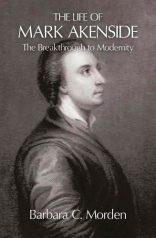Jan 14 2023
The Life of Mark Akenside
THE LIFE OF MARK AKENSIDE: Roger Caldwell commends Barbara Morden’s work in revisiting the life and work of a neglected poet of the 18th century
The Life of Mark Akenside Barbara C. Morden McNidder & Grace ISBN 978085716237352295 139 pp. £14.99
I first came upon the name of Mark Akenside many years ago when reading through Roger Lonsdale’s pathbreaking 1984 Oxford Anthology of Eighteenth-Century Verse which resurrected a good many poets and poems that had been long-forgotten. Akenside is represented there by only a few pages, but those few pages were :sufficient to reveal to me a sensibility markedly different from that of an age which prized reason, form and common sense, and downplayed the faculty of the imagination. By contrast Akenside makes it central: ‘The Pleasures of the Imagination’ is the title he gives to the most ambitious of his works. In particular I was puzzled by how often he reminded me of Wordsworth, despite the fact that Wordsworth was born in the same year (1770) that Akenside died. For example, Akenside records moments when “Every thought in silence hung”, clearly presaging what in Wordsworth were to become “spots of time”. Barbara Morden’s new biography does much to dispel this puzzlement.
For Akenside was a major stimulus to the early Romantics: both Wordsworth and Coleridge freely borrowed from him. That influence extends to the next generation of Romantics. In Keats’ odes of 1819 there are echoes of Akenside’s odes published in 1745, and it is Akenside who first coined the phrase “Beauty is Truth, and Truth Beauty”. Though a man of the eighteenth century, Akenside was looking to the future, trying to free himself from what he saw as unnecessary restrictions and faded poetic conventions, and travelling down “secret paths erewhile untrod by man, / The fair poetic region, to detect / Untasted springs”.
As a man of science he doesn’t deny that “numbers, figures, motions, laws” are applicable to nature, but for Akenside the merely material and mathematical is only a superficial aspect of nature. Nor, contra the philosophy of Locke, is the human mind a matter of mechanics: there is a “mysterious fabric” which has no mechanical explanation and is the creative power of the imagination. It is this power which visits him in his youth when on the banks of Tyne she “sealed me as her own”. Addressing “Northumbrian shades” he recalls “that delightful time / When all alone, for many a summer’s day, / I wander’d through your calm recesses, led /In silence by some powerful hand unseen”. The locale may be a little north of Wordsworth’s but the experience of being called by the voice of nature is essentially the same.
Akenside was brought up in a Unitarian household in Newcastle where his father (though of yeoman farmer stock) was a fairly prosperous butcher. He attended Edinburgh University, intending to train as a Unitarian minister but, feeling no sense of vocation, switched to medicine. He completed his degree in Leiden with a dissertation on embryology which attacked the then-dominant preformationist dogmas. At the same time he emerged as a political satirist, though apparently he kept quiet about his republican ideals when he became Physician-in-Ordinary to Queen Charlotte. There are no records of any love-affairs, and he never married. He lived a sort of double life, as a successful and fashionable doctor and as a poet – his works continued to be reprinted long after his death though they eventually fell into oblivion. His ideas were influential not only in poetry but also in the visual arts. Turner enthusiastically embraced what he had to say on visual perception: where Akenside speaks of “expressive semblance” Turner speaks of “poetic colour”. Art’s expressive powers must be extended to depict our own transient experiences of an ever-changing natural world. This cannot be done, as Akenside knew, by following rules.
It may be surprising that such an important link between the sensibility of one age and that of another should have become so largely forgotten. But it is often the fate of precursors to be supplanted by those for whom they have made way. Much that is in Wordsworth, for example, is already adumbrated in Akenside, but there is no doubt as to which of them is the greater poet. Nor should we forget the very real virtues of eighteenth-century poetry at its best – in its intelligence and wit and sense of lived realty. To speak of its didacticisim is not a valid criticism. Akenside’s poetry is didactic in attempting to express a sort of philosophy. So is Wordsworth’s – and for the same reason. But as the poet as civilised man or woman speaking to other civilised men and women gives way to the poet as solitary “sacred bard” (in Akenside’s phrase) there is loss as well as gain. Morden’s new book, as well as bringing back to life an undeservedly neglected figure, provides much unfamiliar material that enables us to think anew about the nature and role of poetry in general.

15/01/2023 @ 17:32
I greatly enjoyed reading this review and recall from school reading selections from Akenside, as being a precursor to the Romantics. I was captivated by the statement that he “first coined the phrase ‘Beauty is Truth, and Truth Beauty’.” Looking through “The Pleasures of the Imagination,” I could not come up with that coinage, and perhaps, it appears in another of his poems.
There is this from “The Pleasures of the Imagination”:
Thus was beauty sent from heav’n.
The lovely ministress of truth and good
In this dark world : for truth and good are one,
And beauty dwells in them, and they in her,
With like participation.
–Mark Akenside, The Pleasures of the Imagination (1754),
pp. 35-37
This is definitely a book that I have put on my buy list!